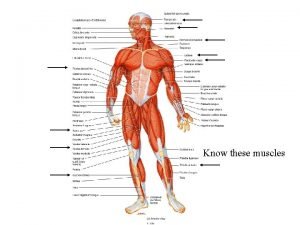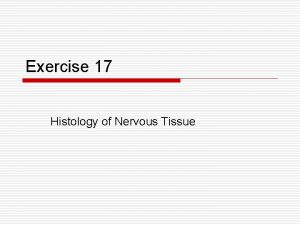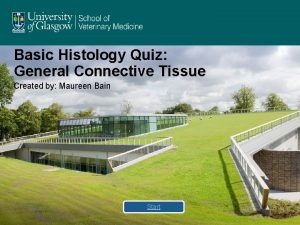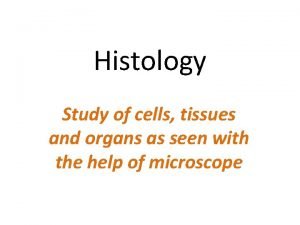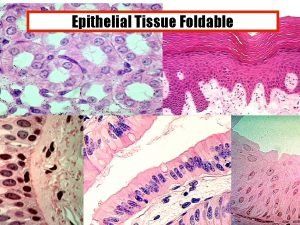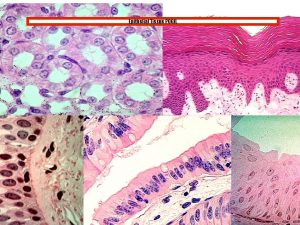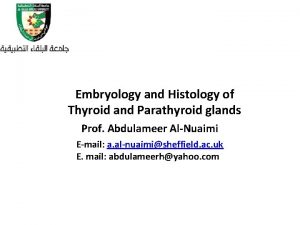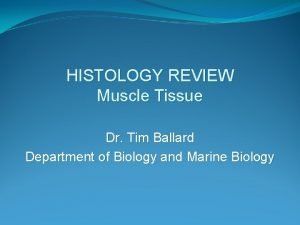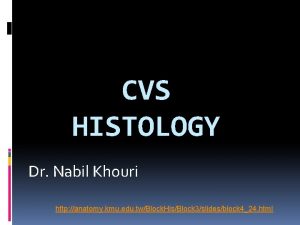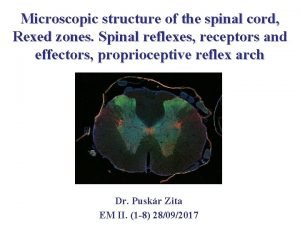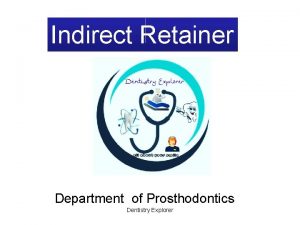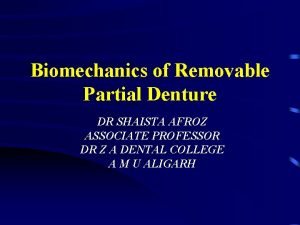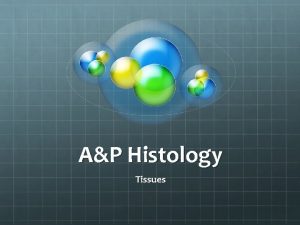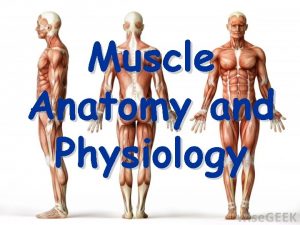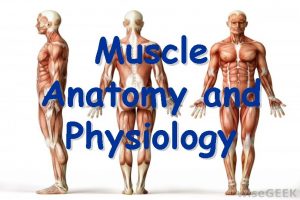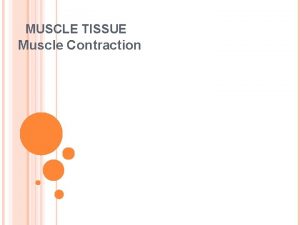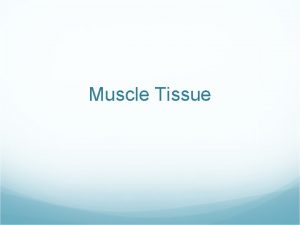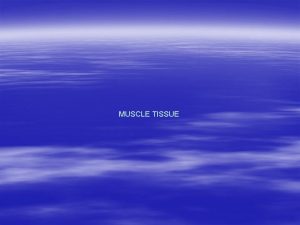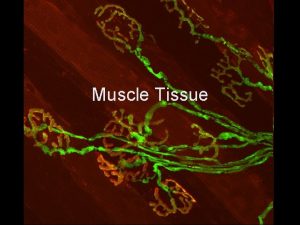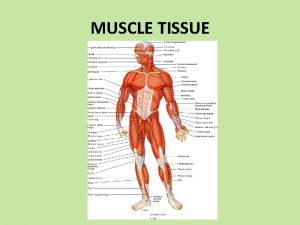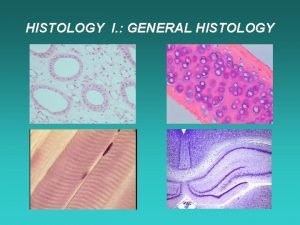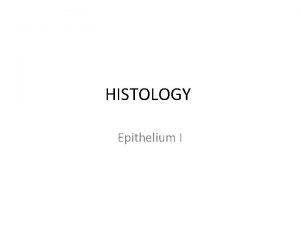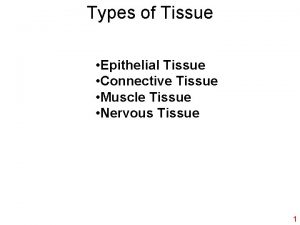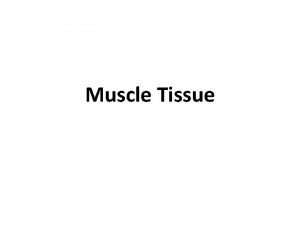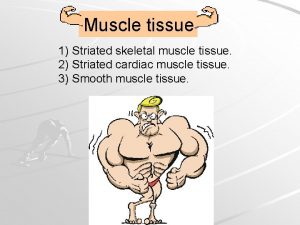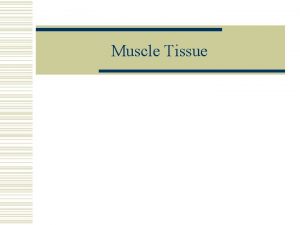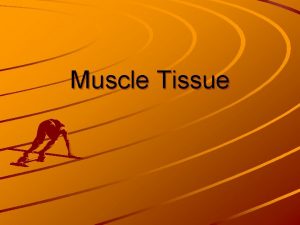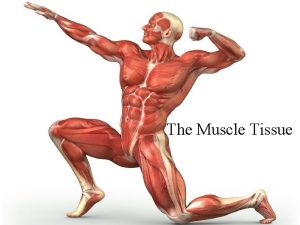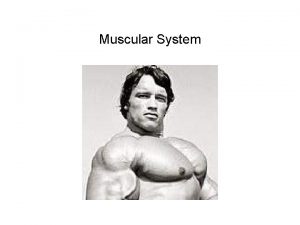Muscle Histology Functions of muscle tissue Movement Joint






















- Slides: 22

Muscle Histology

Functions of muscle tissue § Movement § Joint stabilization § Heat generation

Special functional characteristics of muscle § Contractility § ability to shorten and thicken (when muscles work they contract that is they get shorter and thicker) § Excitability § ability to respond to stimulus

Special functional characteristics of muscle Extensibility ability to stretch (when muscle is relaxed it becomes longer and thinner) *some muscles work while others relax * Elasticity ability to return to original length

Types of Muscle Tissue Skeletal muscle Cardiac muscle Smooth muscle

Types of Muscle Tissue Skeletal • Attach to and move skeleton • 40% of body weight • Fibers = multinucleate cells (embryonic cells fuse) • Cells with obvious striations • Contractions are voluntary Cardiac: only in the wall of the heart • Cells are striated • Contractions are involuntary (not voluntary) Smooth: walls of hollow organs • Lack striations • Contractions are involuntary (not voluntary)

Similarities… Their cells are called fibers because they are elongated Contraction depends on myofilaments Actin Myosin Plasma membrane is called sarcolemma Sarcos = flesh Lemma = sheath

Skeletal muscle Epimysium: surrounds whole muscle Perimysium is around fascicle Endomysium is around each muscle fiber

Attachments Tendon ~ strong, tough connective tissue cord, connect muscle to bone *Achilles Tendon (attaches to calf muscle and heel bone) *lumbodorsal fascia (surrounds the deep muscles of the back and trunk) Origin: the less movable attachment Insertion: the end of the muscle that attaches to a bone that moves -where the muscle ends Usually one bone moves while the other remains fixed Note: origin and insertion may switch depending on body position and movement produced Skeletal Muscle

Attachments continued Many muscles span two or more joints Called biarticular or multijoint muscles Cause movements at two joints Direct or “fleshy” attachments Attachments so short that muscle appears to attach directly to bone Indirect: connective tissue extends well beyond the muscle (more common) Tendon: cordlike (most muscles have tendons) Aponeurosis: flat sheet Raised bone markings where tendons meet bones ○ Tubercles, trochanters, crests, etc.

Skeletal muscle Fibers (each is one cell) have striations Myofibrils are organelles of the cell: these are made up of filaments Sarcomere Basic unit of contraction Myofibrils are long rows of repeating sarcomeres Boundaries: Z discs (or lines) This big cylinder is a fiber: 1 cell -an organelle

Myofibrils Made of three types of filaments (or myofilaments): Thick (myosin) Thin (actin) Elastic (titin) titin______actin _______myosin

Sliding Filament Model __relaxed sarcomere__ _partly contracted_ fully contracted Sarcomere shortens because actin pulled towards its middle by myosin cross bridges Titin resists overstretching “A” band constant because it is caused by myosin, which doesn’t change length

Another pic

EM (electron microscope): parts of 2 myofibrils Labeled and unlabeled

Sarcoplasmic reticulum Tubules surround myofibrils Cross-channels called “terminal cisternae” Store Ca++ and release when muscle stimulated to contract To thin filaments triggering sliding filament mechanism of contraction T tubules are continuous with sarcolemma, therefore whole muscle (deep parts as well) contracts simultaneously

Some sites showing animations of muscle contraction http: //entochem. tamu. edu/Muscle. Struc. Contr actswf/index. html http: //www. brookscole. com/chemistry_d/tem plates/student_resources/shared_resources/ animations/muscles. html

Types of skeletal muscle fibers Fast, slow and intermediate Whether or not they predominantly use oxygen to produce ATP (the energy molecule used in muscle contraction) Oxidative – aerobic (use oxygen) Glycolytic – make ATP by glycolysis (break down of sugars without oxygen=anaerobic) Fast fibers: “white fibers” – large, predominantly anaerobic, fatigue rapidly (rely on glycogen reserves); most of the skeletal muscle fibers are fast Slow fibers: “red fibers” – half the diameter, 3 X slower, but can continue contracting; aerobic, more mitochondria, myoglobin Intermediate: in between

A skeletal muscle contracts when its motor units are stimulated Amount of tension depends on 1. the frequency of stimulation 2. the number of motor units involved

Muscle hypertrophy Weight training (repeated intense workouts): increases diameter and strength of “fast” muscle fibers by increasing production of ○ ○ Mitochondria Actin and myosin protein Myofilaments containing these contractile proteins The myofibril organelles these myofilaments form Fibers enlarge (hypertrophy) as number and size of myofibrils increase [Muscle fibers (=muscle cells) don’t increase in number but increase in diameter producing large muscles] Muscle atrophy: loss of tone and mass from lack of stimulation Muscle becomes smaller and weaker Note on terminology: in general, increased size is hypertrophy; increased number of cells is hyperplasia

Intercalated disc_____ Cardiac muscle Bundles form thick myocardium Cardiac muscle cells are single cells (not called fibers) Cells branch Cells join at intercalated discs 1 -2 nuclei in center Here “fiber” = long row of joined cardiac muscle cells Inherent rhythmicity: each cell! (muscle cells beat separately without any stimulation)

Smooth muscle • Muscles are spindle-shaped cells • One central nucleus • Grouped into sheets: often running perpendicular to each other • Peristalsis • No striations (no sarcomeres) • Contractions are slow, sustained and resistant to fatigue • Does not always require a nervous signal: can be stimulated by stretching or hormones 6 major locations: 1. inside the eye 2. walls of vessels 3. respiratory tubes 4. digestive tubes 5. urinary organs 6. reproductive organs
 Role of muscle tissue
Role of muscle tissue Nervous tissue histology ppt
Nervous tissue histology ppt Sheeps brain
Sheeps brain Connective tissue histology quiz
Connective tissue histology quiz Where is the simple columnar epithelium located
Where is the simple columnar epithelium located Epithelial tissue pogil
Epithelial tissue pogil Epithelial tissue pogil
Epithelial tissue pogil Histology processing steps
Histology processing steps Thyroid and parathyroid glands
Thyroid and parathyroid glands Tonsil histology
Tonsil histology Cross section of skeletal muscle
Cross section of skeletal muscle Cardiac muscle histology labeled
Cardiac muscle histology labeled Location
Location Renshaw cell inhibition
Renshaw cell inhibition Jaringan epitel dapat ditemukan di
Jaringan epitel dapat ditemukan di Partial denture with retainer
Partial denture with retainer Retentive fulcrum line
Retentive fulcrum line Movements of rpd
Movements of rpd Spool joint lamb
Spool joint lamb Cartilage between vertebrae
Cartilage between vertebrae Non-permanent
Non-permanent Venture meaning in accounting
Venture meaning in accounting Lamb grading chart
Lamb grading chart
